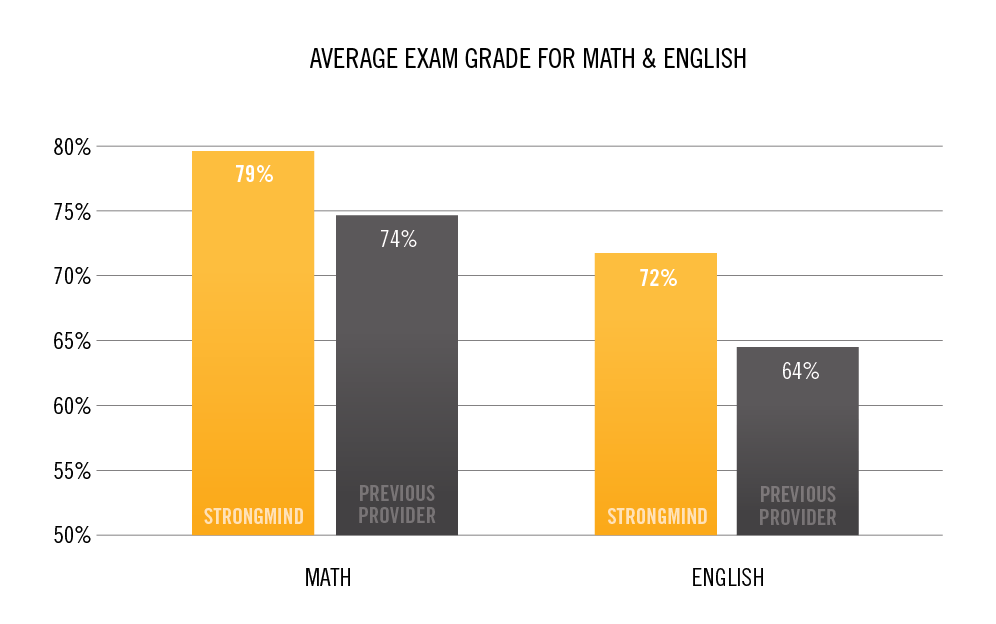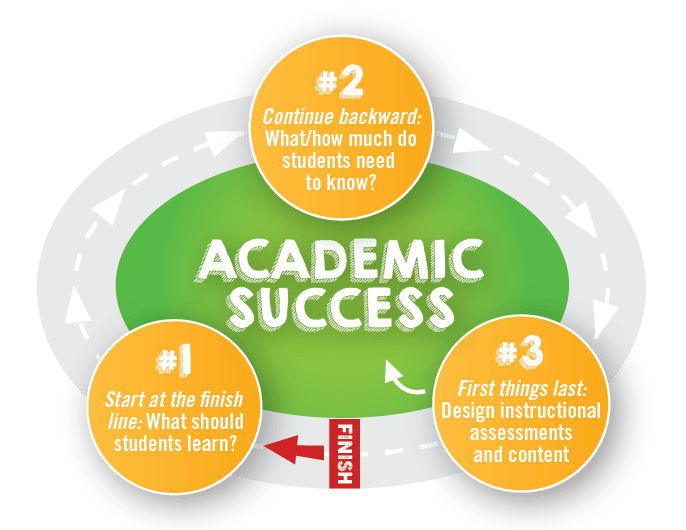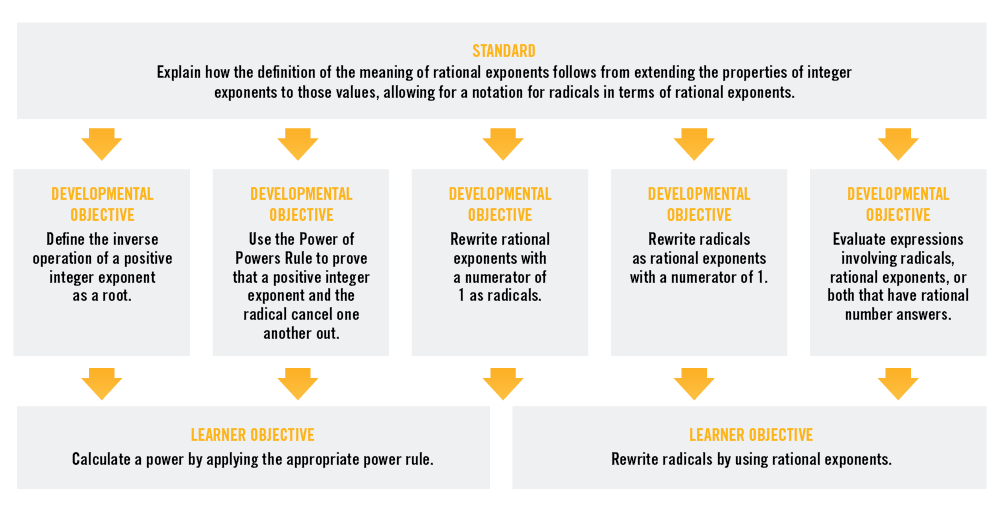
How Planning Backward
Sometimes it makes perfect sense to start off where you want to end up.
StrongMind is doing just that: Building next-generation digital courses by starting with the end in mind. This 70-year-old curriculum design method offers proven, evidence-based results.
It’s called backward design.
The Backward Design Method is “backward” in that it starts with the end by first identifying the desired outcomes, goals or learning objectives (Wiggins & McTighe, 1998) for a course. The course developers then create appropriate assessments based on the desired learning outcomes. Finally they design activities that promote those learning outcomes (Reynolds & Kearns, 2017).
StrongMind uses this evidence-based method in conjunction with high-quality assessments developed by third-party assessment providers that develop valid and reliable assessment items to develop its digital curriculum. Users of StrongMind curriculum are seeing improved academic results almost immediately after launching a new course.
Why StrongMind Employs Backward Design
Backward design provides StrongMind’s instructional design team with standardized, repeatable development processes. This method empowers teachers and students with a focused learning environment that promotes clear and concise learning outcomes. Advantages include:
- Students build the skills and knowledge needed to accomplish necessary learning goals.
- Unnecessary disruptions in the learning process are eliminated.
- Succinct objectives are maintained.
- Teachers spend less time planning courses and more time instructing students.
A study that compared a traditional model of curriculum design to backward design suggests teachers using backward-designed curriculum outperform teachers using a traditional-designed curriculum (Kelting-Gibson, 2005). Lessons using backward design scored higher on key components including knowledge of content and pedagogy, selection of instructional goals, the design of coherent instructions and assessment of student learning.
The Origins of Backward Design
The concept of backward design originated in 1949, with Ralph W. Tyler, an American educator who worked in the field of assessment and evaluation. He introduced the notion when referring to course development constructed from learning objectives. These learning objectives served as the criteria for creating content, including student-facing materials, instructional strategies and assessments (Richards, 2013; Tyler, 1949).
“As StrongMind develops its digital courses using backward design and incorporating Galileo K-12 Online assessments, educators have the ability to drive improved academic outcomes like never before.”
Dr. Jason K FeldVice President of Corporate Projects - Assessment Technology Incorporated
BACKWARD DESIGN IN DETAIL
The Backward Design Method was advocated by nationally recognized educators Grant Wiggins and Jay McTighe in their book Understanding by Design (1998). The Backward Design Method is derived from the Understanding by Design approach and focuses on the purposes, outcomes and desired results of curriculum development. In comparison to forward and central design methods, backward design begins with the desired outcomes and results.
Designing for the learning objective helps course developers focus on the end-goal and ensures that curriculum components are focused and results driven.
Three stages of backward design are implemented to help curriculum designers identify outcomes, establish evidence for achieving desired outcomes and plan evidence-based activities. Through this process, educators design with a deeper understanding of the ideas and experiences students need to be successful learners (Emory, 2014; Wiggins & McTighe, 1998).
It’s Working!
In 2017 StrongMind published its new backward-designed eighth grade math and English courses. The first client to adopt the new curriculum saw immediate results; eighth grade mathematics students’ exam grades increased by an impressive 5% across six unit exams and one final exam compared to performance on unit and final exams in the prior course. In the English course, final exam scores improved by 8% overall.

Prior to publishing these courses, StrongMind’s fully virtual school client used eighth grade curriculum published by well-known content providers in the K–12 space. In addition to lacking rigor, these courses required a great deal of teacher-developed supplemental content in order to adequately align with today’s college and career ready standards.
As teachers using StrongMind’s backward-designed courses further familiarize themselves with the content and develop new instructional strategies specific to their classrooms, StrongMind expects they will continue to drive further improvements.

With backward design, we start with the end in mind.
The Three Stages Applied
The three stages of the Backward Design Method provide StrongMind’s curriculum teams with a focused strategy for developing courses that achieve results.
- Identify desired results.
- Determine what students need to know.
- Plan learning experiences and instruction.
Stage I: Identify Desired Results
StrongMind tackles the first stage of backward design in the analysis phase of curriculum development. During this phase, the instructional designers determine the course standards to be taught based on the defined course goals as well as state and national standards that must be covered for complete alignment.
In developing its Algebra I course, for example, StrongMind used test blueprints from SmarterBalance, PARCC, and numerous other high-stakes testers to inform which standards should be covered in the course and assessed on final exams. They also solicited feedback from students and teachers who have taken or taught the course (or a similar course) in the past and collected assessment data to identify potential pain points for students. This process helps ensure that our courses teach the most important content and the content that will actually be assessed. It also identifies the standards that will require additional reinforcement to ensure student success.
Dedicated to producing effective, engaging experiences
StrongMind’s course development process has many checks and balances. In-house instructional designers, subject matter experts and cognitive learning researchers collaborate closely to ensure backward design is implemented with fidelity. The diversity of their perspectives strengthens StrongMind’s course development process. Each team member shares the ultimate goal of producing effective, engaging learning experiences.
Stage II: Determine What Students Will Need to Know
Designers then begin the second stage of backward design, which starts by building the end-of-course exam. StrongMind uses high-quality assessment banks such as ATI Galileo and KDS Inspect in academic core subject areas. All final exams undergo peer review by a qualified subject matter expert.
Development Objectives & Learning Objectives
Once instructional designers and curriculum developers identify the standards that need to be covered in a course, they begin task analysis. This step pinpoints the development objectives (DOs) that students must be able to complete to achieve success on assessments aligned to the standards. The approach to each standard can vary greatly. Complex standards often require numerous development objectives. By assigning each DO a Depth of Knowledge (DOK) level, the team knows exactly where scaffolding should take place for optimal student performance.
For instance, as shown in the figure below, StrongMind’s in-house subject matter experts and curriculum developers broke down an Algebra I standard into five development objectives. Also listed are the learning objectives (LOs), which are the student-facing objectives that summarize the development objectives. The use of DOs and LOs ensure that large, complex standards are appropriately deconstructed and effectively scaffolded, ensuring that students learn the standard because teachers know what to teach within that standard.
Blueprints
StrongMind also develops course blueprints to outline ways of obtaining acceptable evidence that students have mastered specific concepts. StrongMind uses two types of course blueprints in each course:
- The selected response blueprint specifies the number of computer-graded assessment items to create. These items can be in multiple-choice, multiple-answer and matching formats.
- An extended response blueprint outlines teacher-graded projects and discussion boards.
Between both blueprints, StrongMind can ensure 100% of the standards covered on the final exam are assessed using a variety of activities throughout the course. StrongMind’s instructional designers determine the types of acceptable evidence—that is, how each standard will be assessed—based on the depth and complexity of the learning objective. For example, in the Algebra I course, students demonstrate specific depth of knowledge on a variety of curated activities including multi-module projects, collaborative discussions with peers and responding to questions from a carefully curated question pool.
Stage III: Design Content & Assessments
With analysis and planning complete, the third stage of backward design begins: development. At this point, the instructional designer works with developers and subject matter experts to author formative assessments to assess the objectives in a scaffolded manner. From there, the designers create lessons, individual activities, and multimedia to set students up for success in learning and practicing the course’s objectives.
Content that Engages Digital Natives
Our curriculum developers collaborate with an in-house team of highly skilled creative pros to develop award-winning videos, unique infographics and captivating images and animations. StrongMind’s videographers, artists and graphic artists also use research-based design to create content that resonates with today’s students. For instance, StrongMind’s production team began casting talent two to three years older than the intended grade level after user research showed increased student engagement with slightly older students instead of the typical adult or teacher on screen.
Constant and Intentional Refinement
StrongMind utilizes a “rollout” phase to continuously gather data about courses after they have been developed. This data then feeds directly back into the first stage of backward design, providing a new starting point by identifying newly desired results. This allows StrongMind to iterate courses by identifying where challenges exist, implementing solutions, and evaluating the impact. Constant and intentional refinement is a fundamental component to StrongMind’s course development.
We’re honored!
StrongMind’s digital curriculum has earned over 60 prestigious awards:
- 4 EdTech Digest Awards
- 1 CODiE Award
- 4 CODiE Finalist Awards
- 6 Regional Emmys
- 45 Tellys
- 2 Serious Play Competition Awards
Our Emmy Award Winning Science Video:
Newton’s First Law of Motion
Experts agree: “In reality, there is not one means of engagement that will be optimal for all learners in all contexts; providing options for action and expression is essential” (CAST, 2011).
That is why StrongMind prioritizes the success of all learners by providing multiple means of representation, especially on challenging content. Curriculum teams supplement text-based content with instructional videos, interactive practice and other carefully curated activities that allow students to learn specific content in multiple ways at various points throughout the course.
For example, StrongMind has developed numerous instructional videos based on key areas where students struggle the most (demonstrated by lower completion or grade percentages) in its math courses. Many of these videos are peer-led.
A peer-led video lesson from StrongMind course Math 8B
That’s easy for you to say! Or maybe not… check out our fun bloopers video
Providing Tools for Success
During the initial rollout of StrongMind’s new math curriculum, researchers confirmed what teachers and schools had suspected all along: Students struggle with graphing tools, and students who don’t have access to graphing tools struggle even more. Graphing projects (N=1446) tended to yield average student grades 6% lower than non-graphing projects (N=981) in those same subjects.
In response, StrongMind developed interactive practice opportunities as part of its embedded graphing tools and placed them at key points prior to graded graphing tasks. These interactive tools allow students to pursue as much digitally guided practice as they need to understand and master a concept.
Explore our interactive graphing tool that provides students as much guided practice as needed.
Backward Design & Online Learning
Backward design is also effective and possibly more beneficial than traditional design for curriculum used in online learning environments. A qualitative research study explored student and teacher perspectives of effective online learning experiences (Boling, Hough, Krinsky, Saleem, & Stevens, 2012). The research team interviewed participants in a variety of online programs about their learning experiences.
One program was developed using backward design while the others were not. Both students and teachers had more positive experiences with the program that was developed with backward design (Boling et al., 2012). Student engagement was increased, and their positive experiences were mostly associated with the engaging activities and student/teacher interactions. They responded positively to the activities that incorporated more realistic situations. Teachers responded positively to the organization of backward curriculum design (Boling et al., 2012). Using backward design enables StrongMind’s team to pinpoint the most crucial DOs. As a result, more time can be spent designing engaging activities that target student pain points rather than putting equal emphasis on all content.
In StrongMind’s digital courses, students receive feedback in real time and teachers are given timely, actionable data so they can provide personalized instruction or intervention when and where it’s most needed. This gives students multiple opportunities to practice and understand a concept or skill and avoid developing misconceptions, which are nearly impossible to correct once they’ve been learned and built upon.

Ready to explore how StrongMind can help you attract, retain and graduate more students?
Contributors:
Yovhane L. Metcalfe, Ph.D.
Gail Norlie
Rusty Brandt
Tammy McKeown, Ph.D
Research and Editing:
Kyleigh Rahm
Wendy Brooks
Brian Bujdos
Elizabeth Cree
Graphics and Design:
Kristina Toft
Jaret Lynch
Alex Lockwood
References
Boling, E. C., et al. “Cutting The Distance in Distance Education: Perspectives on What Promotes Positive, Online Learning Experiences.” Internet and Higher Education, vol. 15, no. 2, March 2012, pp. 118–126.
CAST.Universal Design for Learning Guidelines, Version 2.0. Center for Applied Special Technology, 2018, www.udlcenter.org/aboutudl/udlguidelines.
Emory, J. “Understanding Backward Design to Strengthen Curricular Models.” Nurse Educator, vol. 39, no. 3, May-June 2014, pp. 122–125.
Kelting-Gibson, Lynn M. “Comparison of Curriculum Development Practices.” Educational Research Quarterly, vol. 29, 2005, pp. 26–36.
Reynolds, Heather L., and Katherine Dowell Kearns. “A Planning Tool for Incorporating Backward Design, Active Learning, and Authentic Assessment in the College Classroom.” College Teaching, vol. 65, 2017, pp. 17–27.
Richards, Jack C. “Curriculum Approaches in Language Teaching: Forward, Central, and Backward Design.” Regional Language Center Journal, vol. 44, no. 1, April 2013, pp. 5–33.
Tyler, Ralph W. Basic Principles of Curriculum and Instruction. University of Chicago Press, 1949.
Wiggins, G., and J. McTighe. Understanding by Design. Merrill Prentice Hall, 1998.






